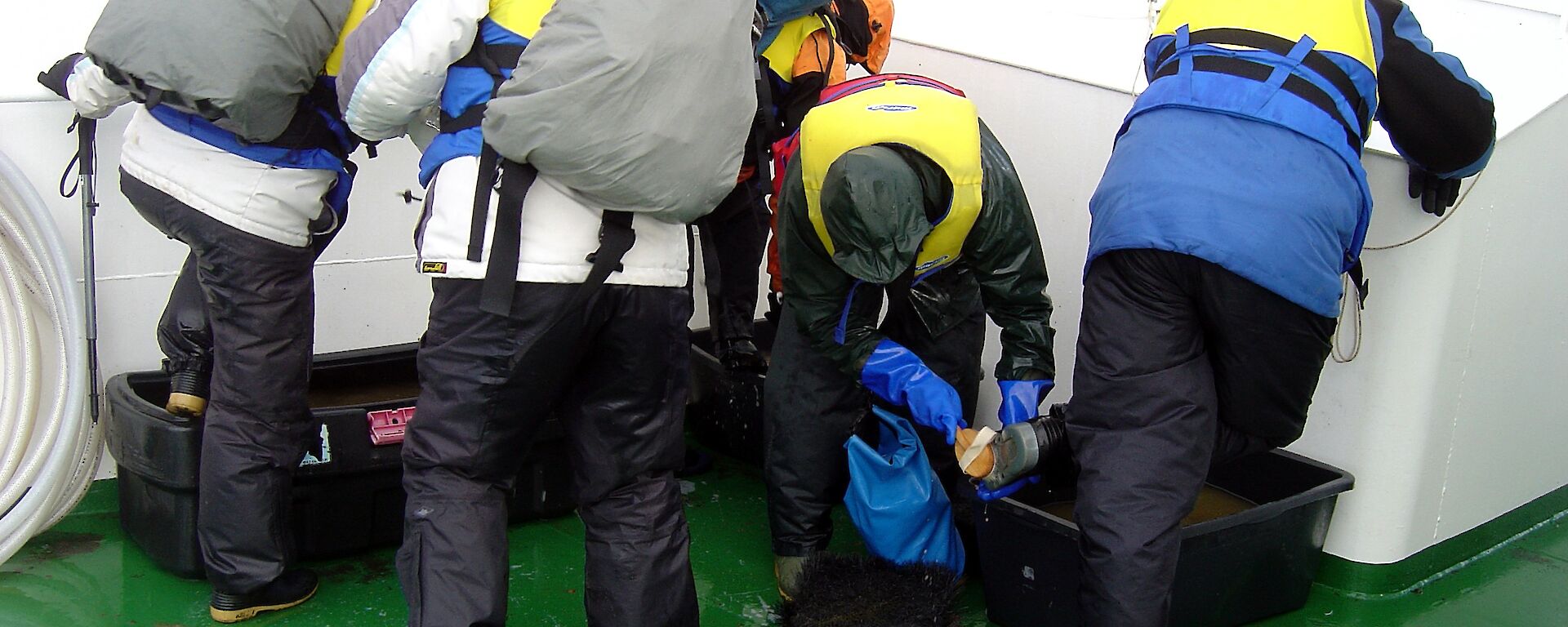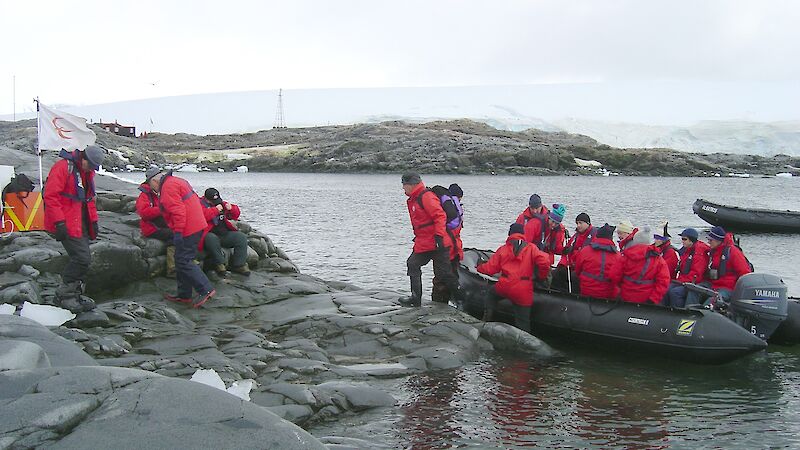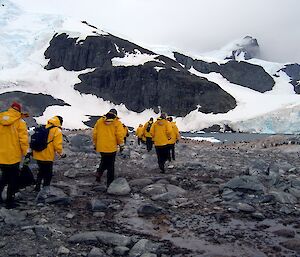Recommendations arising from Antarctic Treaty Consultative Meeting XVIII (Kyoto, 1994)
Activities in the Antarctic are governed by the Antarctic Treaty of 1959 and associated agreements, referred to collectively as the Antarctic Treaty system. The Treaty established Antarctica as a zone of peace and science.
In 1991, the Antarctic Treaty Consultative Parties adopted the Protocol on Environmental Protection to the Antarctic Treaty, which designates the Antarctic as a natural reserve. The Protocol sets out environmental principles, procedures and obligations for the comprehensive protection of he Antarctic environment, and its dependent and associated ecosystems. The Consultative Parties have agreed that, pending its entry into force, as far as possible and in accordance with their legal system, that the provisions of the Protocol should be applied as appropriate.
The Environmental Protocol applies to tourism and non-governmental activities as well as governmental activities in the Antarctic Treaty Area. It is intended to ensure that these activities do not have adverse impacts on the Antarctic environment, or on its scientific and aesthetic values.
This Guidance for Visitors to the Antarctic is intended to ensure that all visitors are aware of, and are therefore able to comply with, the Treaty and the Protocol. Visitors are, of course, bound by national laws and regulations applicable to activities in the Antarctic.
A. Protect Antarctic wildlife
Taking or harmful interference with Antarctic wildlife is prohibited except in accordance with a permit issued by a national authority.
- Do not use aircraft, vessels small boats, or other means of transport in ways that disturb wildlife, either at sea or on land.
- Do not feed, touch, or handle birds or seals, or approach or photograph them in ways that cause them to alter their behaviour. Special care is needed when animals are breeding or moulting.
- Do not damage plants, for example by walking, driving, or landing on extensive moss beds or lichen-covered scree slopes.
- Do not use guns or explosives. Keep noise to the minimum to avoid frightening wildlife.
- Do not bring non-native plants or animals into the Antarctic (eg. live poultry, pet dogs and cats, house plants).
B. Respect protected areas
A variety of areas in the Antarctic have been afforded special protection because of their particular ecological, scientific, historic or other values. Entry into certain areas may be prohibited except in accordance with a permit issued by an appropriate national authority. Activities in and near designated Historic Sites and Monuments and certain other areas may be subject to special restrictions.
- Know the locations of areas that have been afforded special protection and any restrictions regarding entry and activities that can be carried out in and near them.
- Observe applicable restrictions.
- Do not damage, remove or destroy Historic Sites or Monuments, or any artifacts associated with them.
C. Respect scientific research
Do not interfere with scientific research, facilities or equipment.
- Obtain permission before visiting Antarctic science and logistic support facilities; reconfirm arrangements 24–72 hours before arriving; and comply strictly with the rules regarding such visits.
- Do not interfere with, or remove, scientific equipment or marker posts, and do not disturb experimental study sites, field camps, or supplies.
D. Be safe
Be prepared for severe and changeable weather. Ensure that your equipment and clothing meet Antarctic standards. Remember that the Antarctic environment is inhospitable, unpredictable and potentially dangerous.
- Know your capabilities, the dangers posed by the Antarctic environment, and act accordingly. Plan activities with safety in mind at all times.
- Keep a safe distance from all wildlife, both on land and at sea.
- Take note of, and act on, the advice and instructions from your leaders; do not stray from your group.
- Do not walk onto glaciers or large snow fields without proper equipment and experience; there is a real danger of falling into hidden crevasses.
- Do not expect a rescue service; self-sufficiency is increased and risks reduced by sound planning, quality equipment, and trained personnel.
- Do not enter emergency refuges (except in emergencies). If you use equipment or food from a refuge, inform the nearest research station or national authority once the emergency is over.
- Respect any smoking restrictions, particularly around buildings, and take great care to safeguard against the danger of fire. This is a real hazard in the dry environment of Antarctica.
E. Keep Antarctica pristine
Antarctica remains relatively pristine, and has not yet been subjected to large scale human perturbations. It is the largest wilderness area on earth. Please keep it that way.
- Do not dispose of litter or garbage on land. Open burning is prohibited.
- Do not disturb or pollute lakes or streams. Any materials discarded at sea must be disposed of properly.
- Do not paint or engrave names or graffiti on rocks or buildings.
- Do not collect or take away biological or geological specimens or man-made artifacts as a souvenir, including rocks, bones, eggs, fossils, and parts or contents of buildings.
- Do not deface or vandalise buildings, whether occupied, abandoned, or unoccupied, or emergency refuges.
Attachment: Guidance for those organising and conducting tourism and non-governmental activities in the Antarctic
Antarctica is the largest wilderness area on earth, unaffected by large scale human activities. Accordingly, this unique and pristine environment has been afforded special protection. Furthermore, it is physically remote, inhospitable, unpredictable and potentially dangerous. All activities in the Antarctic Treaty Area, therefore, should be planned and conducted with both environment protection and safety in mind.
Activities in the Antarctic are subject to the Antarctic Treaty of 1959 and associated legal instruments, referred to collectively as the Antarctic Treaty system. These include the Convention for the Conservation of Antarctic Seals (CCAS) (1972), the Convention on the Conservation of Antarctic Marine Living Resources (CCAMLR) (1980) and the Recommendations and other measures adopted by the Antarctic Treaty Consultative Parties under the Antarctic Treaty.
In 1991, the Consultative Parties to the Antarctic Treaty adopted the Protocol on Environmental Protection to the Antarctic Treaty. This Protocol sets out environmental principles, procedures and obligations for the comprehensive protection of the Antarctic environment, and its dependent and associated ecosystems. The Consultative Parties have agreed that, pending its entry into force, as far as possible and in accordance with their legal systems, that the provisions of the Protocol should be applied as appropriate.
The Environmental Protocol designates Antarctica as a natural reserve devoted to peace and science, and applies to both governmental and non-governmental activities in the Antarctic Treaty Area. The Protocol seeks to ensure that human activities, including tourism, do not have adverse impacts on the Antarctic environment, nor on its scientific and aesthetic values.
The Protocol states, as a matter of principle, that all activities are to be planned and conducted on the basis of information sufficient to evaluate their possible impact on the Antarctic environment and its associated ecosystems, and on the value of Antarctica for the conduct of scientific research. Organisers should be aware that the Environmental Protocol requires that “activities shall be modified, suspended or cancelled if they result in or threaten to result in impacts upon the Antarctic environment or dependent or associated ecosystems.”
Those responsible for organising and conducting tourism and non-governmental activities must comply fully with national laws and regulations which implement the Antarctic Treaty system, as well as other national laws and regulations implementing international agreements on environmental protection, pollution and safety that relate to the Antarctic Treaty Area. They should also abide by the requirements imposed on organisers and operators under the Protocol on Environmental Protection and its Annexes, in so far as they have not yet been implemented in national law.
Key obligations on organisers and operators
- Provide prior notification of, and reports on, their activities to the competent authorities of the appropriate Party or Parties.
- Conduct an assessment of the potential environmental impacts of their planned activities.
- Provide for effective response to environmental emergencies, especially with regard to marine pollution.
- Ensure self-sufficiency and safe operations.
- Respect scientific research and the Antarctic environment, including restrictions regarding protected areas, and the protection of flora and fauna.
- Prevent the disposal and discharge of prohibited waste.
Procedures to be followed by organisers and operators
A. When planning to go to the Antarctic
Organisers and operators should:
- Notify the competent national authorities of the appropriate Party or Parties of details of their planned activities with sufficient time to enable the Party(ies) to comply with their information exchange obligations under Article VII(5) of the Antarctic Treaty. The information to be provided is listed in Attachment A.
- Conduct an environmental assessment in accordance with such procedures as may have been established in national law to give effect to Annex I of the Protocol, including, if appropriate, how potential impacts will be monitored.
- Obtain timely permission from the national authorities responsible for any stations they propose to visit.
- Provide information to assist in the preparation of: contingency response plans in accordance with Article 15 of the Protocol; waste management plans in accordance with Annex III of the Protocol, and marine pollution contingency plans in accordance with Annex IV of the Protocol.
- Ensure that expedition leaders and passengers are aware of the location and special regimes which now apply to Specially Protected Areas and Sites of Special Scientific Interest (and on entry into force of the Protocol and Antarctic Specially Managed Areas) and of Historic Sites and Monuments and, in particular, relevant management plans.
- Obtain a permit, where required by national law, from the competent national authority of the appropriate Party or Parties, should they have a reason to enter such areas, or a monitoring site (CEMP Site) designated under CCAMLR).
- Ensure activities are fully self-sufficient and do not require assistance from Parties unless arrangements for it have been agreed in advance.
- Ensure they employ experienced and trained personnel, including and sufficient number of guides.
- Arrange to use equipment, vehicles, vessels and aircraft appropriate to Antarctic operations.
- Be fully conversant with applicable communications, navigation, air traffic control and emergency procedures.
- Obtain the best available maps and hydrographic charts, recognising that many areas are not fully or accurately surveyed.
- Consider the question of insurance (subject to any requirements of national law).
- Design and conduct information and education programs to ensure that all personnel and visitors are aware of relevant provisions of the Antarctic Treaty System.
- Provide visitors with a copy of the Guidance for Visitors to the Antarctic.
B. When in the Antarctic Treaty Area
Organisers and operators should:
- Comply with all requirements of the Antarctic Treaty system, and relevant national laws, and ensure that visitors are aware of requirements that are relevant to them.
- Reconfirm arrangements to visit stations 24 to 72 hours before their arrival and ensure that visitors are aware of any conditions or restrictions established by the station.
- Ensure that visitors are supervised by a sufficient number of guides who have adequate experience and training in Antarctic conditions and knowledge of the Antarctic Treaty system requirements.
- Monitor environmental impacts of their activities, if appropriate, and advise the competent national authorities of the appropriate Party or Parties of any adverse or cumulative impacts resulting from an activity, but which were not foreseen by their environmental impact assessment.
- Operate ships, yachts, small boats, aircraft, hovercraft and all other means of transport safely and according to appropriate procedures, including those set out in the Antarctic Flight Information Manual (AFIM).
- Dispose of waste materials in accordance with Annexes III and IV of the Protocol. These annexes prohibit, among other things, the discharge of plastics, oil and noxious substances into the Antarctic Treaty Area; regulate the discharge of sewage and food waste; and require the removal of most waste from the area.
- Cooperate fully with observers designated by Consultative Parties to conduct inspections of stations, ships, aircraft and equipment under Article VII of the Antarctic Treaty, and those to be designated under Article 14 of the Environmental Protocol.
- Cooperate in monitoring programs undertaken in accordance with Article 3(2)(d) of the Protocol.
- Maintain a careful and complete record of their activities conducted.
C. On completion of the activities
Within 30 days of the end of the activities authorisation, organisers and operators should report on the conduct of it to the appropriate national authority in accordance with national laws and procedures. Reports should include the name, details and state of registration of each vessel or aircraft used and the name of their captain or commander; actual itinerary; the number of visitors engaged in the activity; places, dates and purposes of landings and the number of visitors landed on each occasion; any meteorological observations made, including those made as part of the World Meteorological Organisation (WMO) Voluntary Observing Ships Scheme; any significant changes in activities and their impacts from those predicted before the visit was conducted; and action taken in case of emergency.
D. Antarctic Treaty system documents and information
Most Antarctic Treaty Parties can provide through their national contact points copies of relevant provisions of the Antarctic Treaty system and information about national laws and procedures.
- The Antarctic Treaty (1959)
- Convention for the Conservation of Antarctic Seals (1972)
- Convention on the Conservation of Antarctic Marine Living Resources (1980)
- Protocol on Environmental Protection to the Antarctic Treaty (1991)
- Recommendations and other measures adopted under the Antarctic Treaty
- Final Reports of Consultative Meetings
- Handbook of the Antarctic Treaty System (1994)
- Handbook of the Antarctic Treaty System (in Spanish, 1991 edition)
Attachment A
Information to be provided in advance notice
Organisers should provide the following information to the appropriate national authorities in the format requested:
- name, nationality and contact details of the organiser
- where relevant, registered name and national registration and type of any vessel or aircraft to be used (including name of the captain or commander, call-sign, radio frequency, INMARSAT number)
- intended itinerary including the date of departure and places to be visitors in the Antarctic Treaty area
- activities to be undertaken and purpose
- number and qualifications of crew and accompanying guides and expedition staff
- estimated number of visitors to be carried
- carrying capacity of vessel
- intended use of vessel
- intended use and type of aircraft
- number and type of other vessels, including small boats, to be used in the Antarctic Treaty area
- information about insurance coverage
- details of equipment to be used, including for safety purposes, and arrangements for self-sufficiency
- other matters required by national laws.




